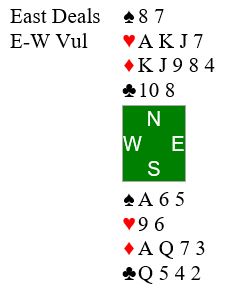Please take a seat at our learning table. At this table you have plenty of time — 7 days rather than 7 minutes — to play the hand! Each Sunday we offer a new puzzle. The puzzle includes hints in the form of questions, questions designed to aid your play or defense. You have a week to analyze clues associated with each hint. Enjoy this week’s mental exercise:
Puzzle 1:
You are South in a contract of 3 notrump. East opened the bidding 2 spades. Then the auction proceded: pass by you, pass by West, double by partner, pass by East, 3 notrump by you, all pass.
Opening lead by West is the queen of spades. Here is what you see:
Think before you play to trick 1:
- Start by counting your sure winners. A sure winner is a trick you can win without losing the lead. Use the result as a basis for deciding best way to come to 9 tricks before the opponents can take 5 tricks.
- Use clues from the auction and opening lead to tentatively visualize the unseen hands. In particular, how do you think spades are splitting on this hand?
- Additional clues will be revealed by opponents’ carding during the play. For example, West shows out on your second round of the diamond suit. Now what to you know about East’s hand?
- Do you have sufficient entries to hand and dummy to execute your plan?
- Should you decide to take a finesse, when is the best time to do it?
- Are your chances of winning the finesse 50 percent?
- Do you see any additional chances that might allow you to avoid the finesse?
- Is there any reason to hold up at trick 1?
Do you have questions or need clarifications? If so, do not hesitate to contact Harry by text (808 854-6147) or email: Hmessenheimer at earthlink.net. Please send your solution to Harry by email before next Sunday. Harry’s solution will be published below next Sunday, including a summary of the fundamentals involved.


